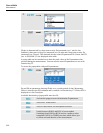
Unbalance
Phasor13
13-3
Cursor. When the Cursor is on, the Trend values at the Cursor are displayed in the screen
header. Moving the Cursor off the left or right side of the screen brings the next of six
screens into the viewing area.
Zoom. Allows you to expand or shrink the display vertically or horizontally to view
details or to fit a complete graph within the screen area. Zoom and Cursor are operated by
the arrow keys and explained in Chapter 17.
Offset and Span are preset for a good display in most cases, but they are adjustable. The
adjustment menu is reached via the SETUP key and function key F3 - FUNCTION
PREF. See Chapter 18, FUNCTION PREFerences.
Phasor
To access the Unbalance Phasor screen:
g
F3
Shows the phase relation between voltages and currents in a vector diagram divided in 30
degree sections. The vector of the reference channel A (L1) points to the positive
horizontal direction. A similar vector diagram is displayed under Scope Phasor.
Additional numerical values are given: negative voltage or current unbalance percentage,
zero sequence voltage or current unbalance percentage, fundamental phase voltage or
current, frequency, phase angles. With function key F1 you can choose readings of all
phase voltages, all phase currents, or voltage and current in one phase.
Available function keys:
F1
Selection of signals to be displayed: V displays all voltages,
A displays all currents. A (L1), B (L2), C (L3), N (neutral)
give simultaneous display of phase voltage and current.
F3
Return to table screen.
F4
Access to trend screen.
F5
Switch between HOLD and RUN of screen update.
Switching from HOLD to RUN invokes a menu to select
immediate (NOW) or TIMED start time which allows you
to define start and duration of the measurement.
Tips and Hints
The voltages and currents in the table can e.g. be used to check if power applied to a 3-
phase induction motor is in balance. Voltage unbalance causes high unbalanced currents
in stator windings resulting in overheating and reduced motor life. Each of the phase
voltages should not differ more than 1 % from the average of the three. Current


















